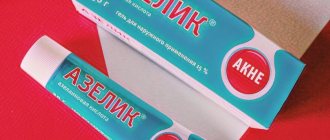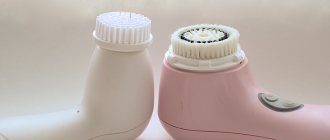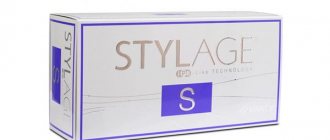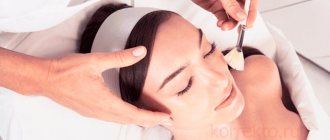We tell you how the alexandrite laser differs from the diode laser in terms of effectiveness and pain. We will talk specifically about hair removal, and not about laser rejuvenation.
To understand how alexandrite and diode lasers work, let’s understand the theory of selective photothermolysis.
The theory of selective photothermolysis is based on the destruction of targets in the skin without damaging surrounding tissue. That is, the laser beam hits the target due to a certain wavelength. The wavelength depends on the working fluid.
The target for laser light is:
- dark pigment melanin in hair and intercellular matrix;
- hemoglobin in the vessel;
- water.
Alexandrite and diode lasers differ from each other in their active medium (working fluid). Due to the active medium, the wavelength of the alexandrite laser is 755 nm. Diode - 808 nm.
What is the active medium or working fluid of a laser?
One of the main components of a laser device is the working fluid or active medium. This is a thing in which electrical voltage is converted into a laser beam. The working fluid enhances the luminous flux. This is what it looks like:
Here's how it works:
- The energy source pumps voltage into the active medium;
- Photons in the active medium begin to move faster and faster;
- They hit optical resonators (mirrors) and the density of stimulated radiation increases;
- A powerful avalanche of photons passes through one of the mirrors, which transmits 50% of the light;
- The emitted photons are the laser beam.
The picture shows an alexandrite laser, but the principle of operation is the same for all. It’s just that the diode’s working medium is diode plates (they look like stripes when you look through the aperture of the handpiece), while the alexandrite’s is crystal. The working fluid is always surrounded by resonator mirrors.
The name of the active medium dictates the name of the laser. The active medium is ruby, which means the laser is ruby, neodymium is neodymium.
The active medium of the alexandrite laser is the mineral alexandrite. Alexandrite is a type of chrysoberyl with an admixture of chromium. Changes color depending on the lighting. For lasers, the mineral is grown artificially.
There are no minerals in diode lasers. Their working fluid consists of two layers of semiconductor material folded together. The active substance is gallium arsenide.
The main cost of a laser is the active medium. The more expensive it is to produce, the more expensive the laser. That is, the cost of an alexandrite laser is always higher than a diode laser, all other things being equal.
How does laser irradiation work?
The laser allows you to remove hair from the face and body due to the coloring pigment melanin it contains.
Due to the laws of physics, skin and hair cells have the ability to absorb light waves and convert them into thermal energy. When the laser was invented, it became technically possible to do long-term hair removal. It was possible to continue to remove hair mechanically, simply by tearing it out by the roots, but it turned out that it was much more effective to act not on the hair itself, but on the bulb.
They took a laser and sent a beam to the place where the hair grows. The hair shaft, which contains an abundance of melanin, absorbs light, and heat is transmitted down it to the follicle. Since the temperature was initially high, the thermal impulse that reached the hair root was somewhere around 70–80°. This was enough for the bulb to receive a severe burn and atrophy for a long time. Hair fell out from the damaged follicle, and a new one could no longer grow due to the lack of blood supply and nutrient medium in the follicle.
From a physiological point of view, laser irradiation injured tissues and caused harm to the body, but the only visible consequences were lost hair, which, in fact, was what the developers of the technology sought.
In the same way, as it became clear later, you can remove plain tattoos. The fading dark paint began to be split with a laser beam into micropigments and burned out like hair cells containing melanin.
During hair removal, irradiation practically did not affect soft tissues: except, perhaps, for the first generation ruby lasers, which had a short wavelength. The installations that appeared by the 1930s were already working on alexandrite, then others appeared, using diodes. They turned out to be so easy to use that they are still used in salons. Supporters of laser hair removal are still divided into two camps: “fans” of the alexandrite laser and the diode laser.
Typically, a salon only works on one unit; sometimes you need to look for an establishment with the necessary equipment, especially in small towns
What is the difference between a diode laser and an alexandrite laser?
Laser diodes are similar in operating principle to light-emitting diodes (LED lamps). The design of such lamps consists of microcircuits made of semiconductor elements that convert an electrical impulse into a light beam of the desired color and length. In cosmetology, diode lasers are used only for hair removal, and for this procedure such equipment still remains the “gold standard”, despite the emergence of new laser hair removal technologies like iPlaser.
Doctor N. I. Tsisanova about the diode laser - video
They started working with the alexandrite laser in aesthetic medicine earlier than with the diode laser. Its scope of application is not limited to hair removal alone; it can also remove plain tattoos.
The equipment uses the ultra-strong mineral alexandrite (hence the name of the technology), which is grown artificially. Manufacturers of alexandrite lasers have long established themselves in the market: the quality remains consistently high. But you have to pay for it - and a lot. To recoup the cost, the salon sometimes charges a higher price for hair removal using alexandrite than for other laser equipment (although not everywhere, these are isolated reviews). It happened that patients even complained about the inflated cost, because no one guarantees any super results from hair removal on alexandrite - such as permanent hair removal. That is, both the effect of the procedure and the level of comfort during hair removal are, let’s say, standard.
Cosmetologist E. Vashunina about hair removal with an alexandrite laser - video
Technical characteristics of diode and alexandrite laser - table
| Options | Diode laser | Alexandrite laser | |
| Light spot diameter | 9 mm | 18 mm | |
| Device power | 0.5 kW | 2 kW | |
| Light wavelength | 800 nm | 755 nm | |
| Cooling system | No | Yes | |
| Skin type (according to Fitzpatrick) | I-VI | I-III | |
| Possibility of side effects | High | Low | |
Diode laser allows hair removal on all skin types, alexandrite laser - only on light skin (phototype I-III)
Similarities and differences
4
There is no way to definitively answer which laser is better, alexandrite or diode, since each is unique in its own way. Namely:
- Diode is suitable for people of any photo type. For alexandrite, only 1-2 phototypes are suitable.
- After working with alexandrite equipment, hairs will disappear within 5 days. And in the second case, only after a few weeks.
- The duration of a session with a diode device is about 2.5 hours. Otherwise, 45 minutes is enough.
If you consider the reviews of specialists, people who have already used the services of cosmetologists, you can understand what is better for hair removal - an alexandrite or diode laser. In general, both options cannot cause side effects, with the exception of redness. Efficiency is practically the same. Both techniques remove dark, hard rods. Proper implementation of the technology eliminates negative consequences.
How to prepare for hair removal with an alexandrite laser, and how with a diode laser
If you have signed up (or are planning to sign up) for laser hair removal - no matter which laser, follow the general recommendations for 2 weeks before the procedure - this will help avoid side effects:
- Be sure to visit a doctor and find out if there are any contraindications;
- If you are prone to herpes, start taking antiviral drugs - but you need to talk about this with your doctor. The fact is that after the procedure, herpes may appear as a reaction to skin injury;
- limit visits to the solarium;
- reduce sun exposure;
- refuse water treatments.
It is believed that it is acceptable to work with tanned skin on modern models of diode lasers. But in any case, details should be clarified with a cosmetologist during a preliminary consultation. Until you have had your initial examination, follow the standard rules. Be sure to check when making an appointment what equipment is used in the salon you have chosen. If this is an alexandrite laser, then stop removing hair from the root in advance. By the day of the procedure, there should be at least short stubble in the problem area. There is no need to leave a length greater than 3 mm - after epilation, the hairs will become charred and will cling to clothes and underwear and get in the way. But hair removal with alexandrite is not carried out on smooth skin - unlike diode, which is used specifically on smooth skin. This does not mean, of course, that you can pull out the hair by the roots before the procedure itself. But you can simply not grow them back, but shave them clean with a machine or remove them with a depilatory cream.
The day before the procedure, you can take a bath, steam the skin well and apply plenty of emollient cream or milk. Immediately before visiting the salon, about an hour before, you can take a painkiller and apply a spray (gel) with lidocaine to the problem area. This is especially appropriate if your skin is sensitive.
For epilation with alexandrite, you need to leave stubble; before epilation with a diode laser, the hair can be shaved clean or removed with a depilatory cream
comparison table
| Comparison criterion | Diode type | Alexandrite type | |
| Working fluid | Two layers of semiconductor material (diodes) | Artificially grown mineral alexandrite, enriched with chromium | |
| Wavelength | 800-980 nm | 725-755 nm | |
| Beam spot size | 5-12 mm | 12-18 mm | |
| Pulse frequency | 1-10 Hz | 1-5 Hz | |
| Pulse duration | Up to 40 ms | Up to 30 ms | |
| Operating principle | Heats melanin, destroys blood and lymphatic vessels that feed them | Heats the pigment in the hair follicle, causing it to collapse | |
| Recommended skin phototype according to Fitzpatrick | 1-5 | 1-2 | |
| What hair does it remove? | All except the gray ones | Only dark ones | |
| Indications | Excessive body hair due to genetic characteristics of the body or hormonal imbalances, ingrown hairs after shaving | ||
| Contraindications | Skin diseases, various damage (scratches, wounds) to the treated surface, pregnancy, diabetes mellitus, period of treatment of hormonal diseases, tendency to form keloid scars, severe tanning | ||
| Effect after the procedure | It takes up to 10 days for all affected hairs to fall out | Smooth surface immediately after the procedure | |
| Recommended hair length before the session | — | 2-3 mm | |
| Duration of the procedure | Depends on the treated area and their number, from 10 to 70 minutes | ||
| Number and frequency of repeated sessions | 8-10 treatments every 4-6 weeks | 6-8 sessions every 5-8 weeks | |
Are there any differences in the hair removal procedure itself?
Before starting any hair removal, the doctor cleans and disinfects the skin in the problem area, then applies a cooling gel (or topical anesthesia). The device screen is also treated with an antiseptic. When the required radiation power is set - and it is matched to the color of the skin and hair - the doctor presses the handpiece to the skin and turns on the device. If hair removal is carried out with an alexandrite laser (the latest generation), then almost immediately after the flash has taken effect, cooling liquid is supplied to the treated area. This is due to the large area of the light spot - without a cooling system, the procedure would be much more painful.
Alexandrite laser systems have a larger light spot diameter; without a cooling system, the pain would be unbearable
With a diode laser, cooling occurs inside the laser gun itself. For the patient, this means slightly more pain during radiation - although if anesthesia is given, it will be quite tolerable. In patients with a high pain threshold, the sensations are reduced to a slight burning and tingling sensation. Cases where women refused the procedure due to unbearable pain are isolated.
The diode laser beam is narrowly focused, so the pain is tolerable and there is no need to supply coolant after each flash.
The duration of the procedure varies: the bikini area, for example, can be treated with a diode laser in half an hour, with an alexandrite laser - an hour or a little more. The frequency of sessions is approximately the same. Approximately - because each patient is assigned an individual schedule for visiting a doctor. Judging by the reviews:
- epilation is done on the face about once a month;
- on the armpits - once every 4 weeks;
- in the bikini area and on the stomach - once every 5 weeks;
- on the legs - once every 6 weeks.
The full course of treatment ranges from 6 to 10 procedures. Keep in mind that laser hair removal is not for everyone and may simply not produce results even after 5 sessions. The lack of the desired result is explained, firstly, by heredity, and secondly, by a malfunction of the endocrine system and hormonal imbalances. If you notice excessive hair growth, even before the hair removal course, you should go to an endocrinologist and get tested for the thyroid gland. There were cases when treatment solved the problem of too thick/dark/coarse hair on the body: it did not fall out completely, but since there was less of it, and new ones grew thinner and softer, the hair removal course cost much less money, and the patient knew that the result it will be for sure.
Estimated cost of laser hair removal depending on equipment - table
| Zone | Face | Armpits | Bikini (deep) | Legs (full) |
| Price per procedure using alexandrite laser | 1500–2000 | 3000–4000 | 7000–9000 | 9000–15000 |
| Price for diode laser procedure | 1500 | 3000 | 7000 | 9000–10000 |
Often in salons the price for a flash is indicated, and it can cost from 10 to 100 rubles, depending on the hair removal area.
For the patient, the hair removal procedure using a diode alexandrite laser is characterized by the duration and pain of the procedure.
What does laser hair removal feel like?
The laser flashes feel like hot tingling or tiny pinches when removed. All due to the fact that the hair heats up to 70 degrees. The pain goes away immediately due to cooling. Compared to waxing or sugaring, laser hair removal is a faster and more comfortable procedure.
Feelings are a subjective thing. Patients have different pain thresholds. Even the phase of the menstrual cycle affects skin sensitivity in women.
At the beginning of the procedure, the specialist, according to the procedure protocol, starts with low power and asks about sensations. Then it increases it to select comfortable parameters.
Possible side effects
After epilation with a diode laser, side effects are rare; the rehabilitation period takes 2–3 days. Redness and slight swelling of the skin are normal; burns after a diode laser are extremely rare: when the procedure was carried out at too high a power that does not correspond to the parameters of the skin and hair. With increased photosensitivity, hyperpigmentation may occur.
After an alexandrite laser, it takes 10–14 days for the skin to recover; redness, tissue swelling, and pain when pressed take longer to disappear. If the procedure is performed on a patient for whom it is not indicated—a woman with dark skin, for example, there is a high probability that the person will return from the salon with burns of varying severity and accompanying tissue swelling. After healing, pigment spots may appear.
Side effects from any laser occur due to non-compliance with the doctor’s recommendations for skin care before and after the procedure
Skin care after the procedure
After laser hair removal, the skin requires special care. After completion of the session, slight redness may appear, which goes away without intervention in about a day. On particularly sensitive skin, inflammation lasts a little longer. Such manifestations are relieved with special sprays, ointments and creams that have an anti-inflammatory effect and promote recovery.
After laser hair removal, it is recommended to follow these recommendations:
- not using alcohol-containing cosmetics;
- abstaining from visiting baths and saunas to prevent inflammation of the skin;
- protection of treated skin areas from water during the day;
- refusal to use a hard washcloth when bathing;
- use of sunscreen and avoidance of sunbathing.
- It is also not recommended to remove crusts from burns on your own, as such actions lead to the appearance of scars. For successful laser hair removal, it is important to follow all rules and recommendations.
Which laser is better - alexandrite or diode?
The first thought that comes to our mind when we are about to sign up for a new procedure is our safety. And only then the possible result. Yes, the equipment must be powerful enough so that some of the bulbs die after the first procedure. In this regard, the alexandrite laser has better performance and its power is higher. Therefore, there are patients - mostly with fair skin and dark hair - who were not helped by hair removal with a diode laser, and after several sessions with an alexandrite laser, their hair immediately became smaller.
But the diode has a longer wavelength, that is, it shines through deeper. This means that melanocytes, which lie in the middle layer of the dermis, directly absorb this light. The higher the degree of absorption of the laser beam by melanin, the lower the heating coefficient of its surface and the lower the likelihood of getting a burn.
The wavelength also determines the duration of the procedure - with a diode laser, hair removal will be faster, although it will be more painful. It will be easier to endure pain in the area of the upper lip, where the facial nerves are located, with an alexandrite laser, which has a cooling system.
The difference in the area of the light spot is not felt if hair removal is carried out over a large area - arms, legs, back, chest, abdomen. If there is a need to remove hair in the bikini area, including the deep one, that is, on the intergluteal fold, there may be gaps after the alexandrite laser. Hard-to-reach areas are easier to treat with a small-diameter beam. And one more thing: if you epilate on alexandrite at least once - no matter in what zone - after the first procedure you will have to endure the stubble that grows for epilation for 2-3 days. It doesn't fall out right away, it takes some time. In this regard, hair removal using a diode laser, for which you do not need to grow your hair, which means you don’t have to endure it later.
Diode or alexandrite laser: which one to choose - blogger’s experience - video
Types of lasers
All lasers are distinguished by wavelength, fluence, duration of exposure and parameters of the working environment. Fluence is the time integral of the flux density or the speed of particle transfer.
Generates particles of a substance capable of converting an electrical charge into a focused beam of light and enhancing its effect. Alexandrite has these properties, but there is not much of it in nature.
Therefore, in order for such a substance to work as long as possible and be used more, artificial crystals are grown on special “farms”, which have become the basis for alexandrite lasers. There are also good old semiconductors; they are the basis for the operation of diode lasers.










